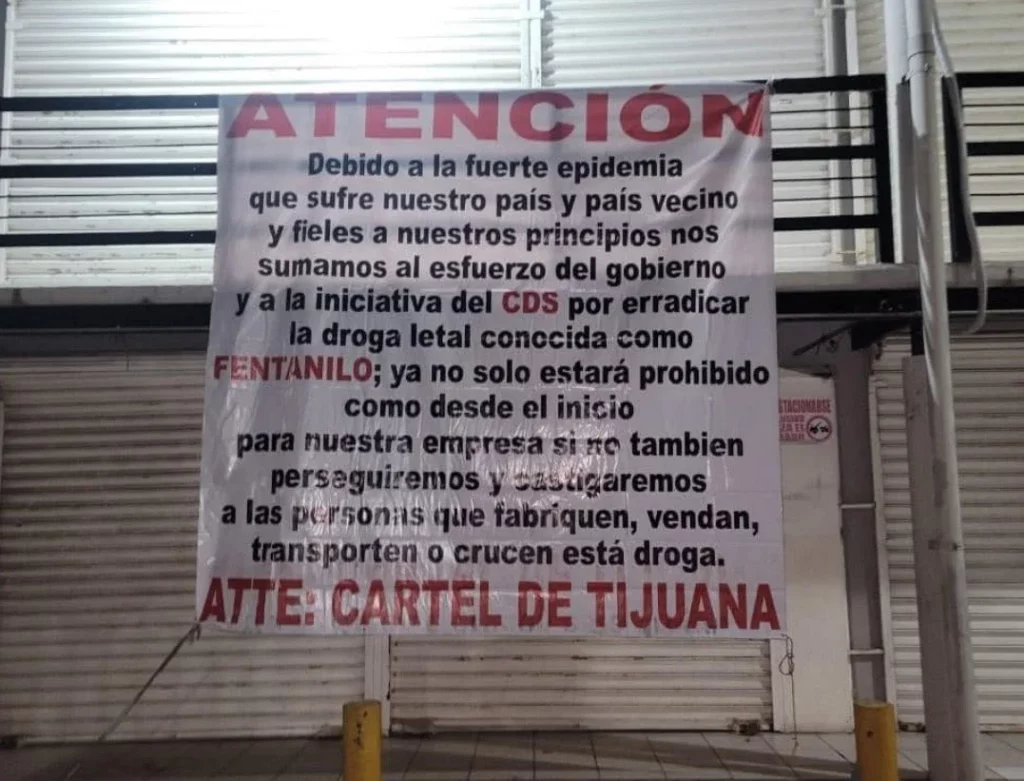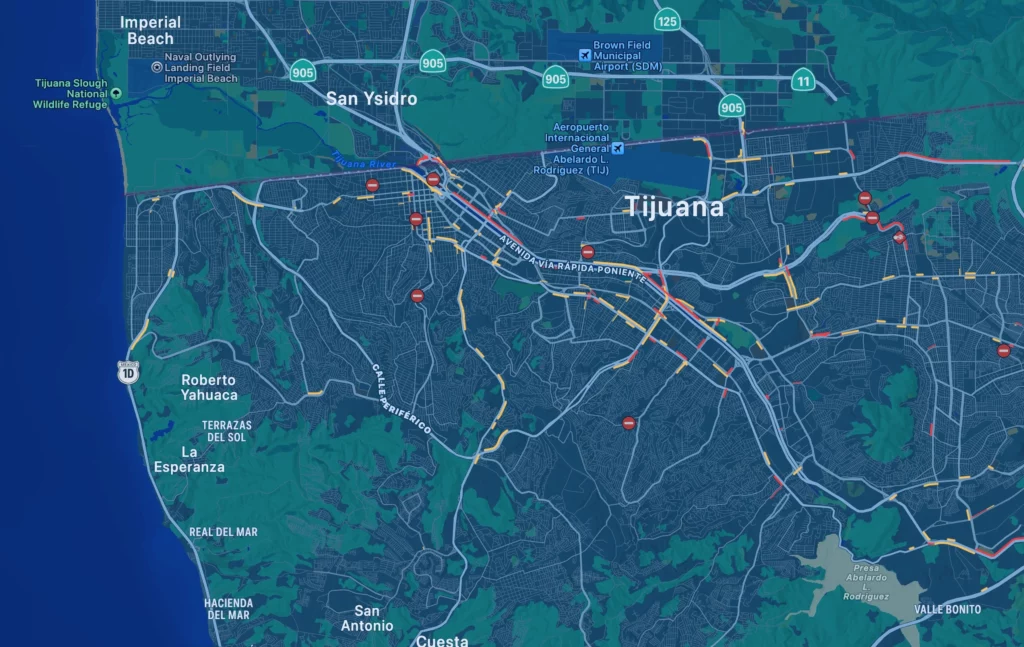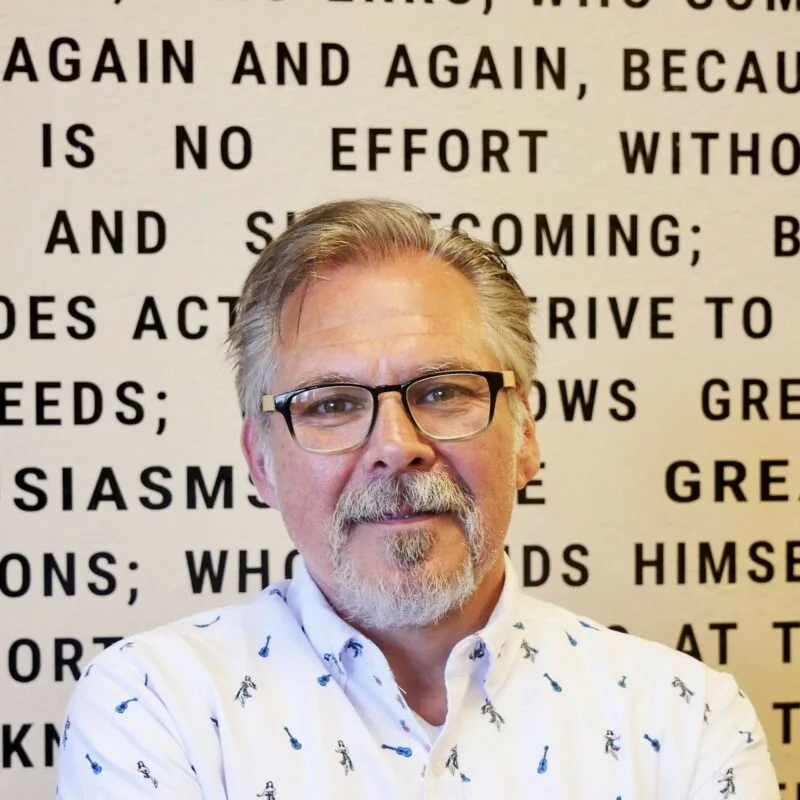Published: October 19th, 2023 at 4:43 PM
Some of Mexico’s drug cartels have recently changed their position on fentanyl, a potent and lethal synthetic opioid.
The Arellano Félix Cartel in Tijuana and some groups in Sinaloa have publicly declared that they will no longer sell or produce fentanyl.
This shift in stance has led to bilateral talks between the United States and Mexico, which are focused on the fentanyl crisis, migration issues, and weapon trafficking.
But can this statement be believed? Let’s examine these developments, highlighting the collaborative efforts of the two countries and the changing dynamics in Mexico’s drug trade landscape.
A Joint Stance Against Fentanyl

The message from the drug cartel reads as follows1:
“Due to the strong epidemic suffered by our country and our neighboring country.
And while being faithful to our principles.
We join the government’s effort and the CDS initiative to eradicate the lethal drug known as fentanyl.
It’ll now be prohibited to sell as it initially was from our company.
In addition, we will also prosecute and punish anyone who manufactures, sells, transports or crosses this drug over international borders.
Yours truly, The Tijuana Cartel“
The Felix Cartel’s Decisive Move
In recent news, the Arellano Félix Cartel from Tijuana announced a strict halt on selling fentanyl through public messages.2
This move, mirroring similar actions by other cartels, is speculated to be an attempt to lessen the scrutiny from law enforcement.
Strong Warning to Sinaloa
Soon after, the streets of cities such as Culiacán, El Rosario, Angostura, and Guamúchil in Sinaloa were peppered with warnings, allegedly from Los Chapitos, against fentanyl-related business activities.
These directives soon spread to the Altar region of Sonora, reflecting a broader shift in the stance against fentanyl’s production and trade.
Bilateral Talks: Mexico and U.S. Collaboration
In response to these ground movements, top security officials from Mexico and the U.S. convened to strategize to curb the fentanyl epidemic.
Their dialogues expanded to address migration challenges and weapon trafficking into Mexico.
Alicia Bárcena Ibarra, leading the Mexican Ministry of Foreign Affairs, emphasized the need for mutual action against synthetic drug trade and curbing arms flow.
The Debate on Fentanyl’s Origin
A significant point of contention during these talks was fentanyl’s origin.
While U.S. Secretary of State Antony Blinken contended that the drug devastating U.S. populations has its roots in Mexico, Rosa Ícela Rodríguez Velázquez, Mexico’s Secretary of Public Security, argued otherwise.
However, Todd Robinson from the State Department supported Blinken’s claim, noting that while the drug’s precursor chemicals come from China, the synthesis occurs in Mexico.
Concentrated Efforts in Sinaloa
Although the drug’s origin remains debatable, Mexico’s proactive efforts in confiscating vast quantities of fentanyl and methamphetamines are evident.
Data suggests a pronounced focus on Sinaloa, with a whopping 89% of the drug labs seized during López Obrador’s leadership being located there.
Meanwhile, regions like Durango, Michoacán, and Jalisco witnessed fewer operations.
The Road Ahead
As the discussions wrapped up, Merrick Garland, expressing gratitude towards the Mexican government, alluded to further joint initiatives, emphasizing collaboration.
The dialogue also witnessed insights from prominent figures like U.S. Secretary of Homeland Security Alejandro Mayorkas, Mexico’s Secretary of the Navy Rafael Ojeda, and Luis Cresencio Sandoval, head of Sedena.
By implementing this ban, the Arellano Félix Cartel aims to contribute to the overall goal of eradicating fentanyl and reducing the harm caused by its consumption.
The hope is that these collective efforts will mark a significant step in addressing the challenges posed by fentanyl.
The Arellano Félix Cartel: A Brief History
The Arellano Félix Cartel, also known as the Tijuana Cartel, has a notable and turbulent history in drug trafficking and violence.3
Originating in Tijuana, Mexico, this criminal organization was founded by the Arellano-Félix family and gained a reputation as one of the country’s largest and most violent cartels.
The cartel’s roots can be traced back to the state of Sinaloa, where its founding members had close ties with the notorious drug lord Miguel Ángel Félix Gallardo.
However, it was in Tijuana that the Arellano Félix Cartel flourished and established its stronghold.
Key members of the cartel, such as Benjamín Arellano Félix, Eduardo Arellano Félix, and Ramón Eduardo Arellano Félix, played pivotal roles in the organization’s operations.
They were involved in the smuggling of large quantities of drugs, primarily cocaine, marijuana, and later methamphetamine, across the border into the United States.
Over the years, the Arellano Félix Cartel gained notoriety for its brutal tactics and involvement in numerous murders.
The cartel’s control over drug trafficking routes in Tijuana allowed them to amass significant wealth and influence in the region.
However, their reign of power was challenged by law enforcement efforts, resulting in the capture or death of several key members.
This included Ramón Eduardo Arellano Félix, considered one of the most violent leaders of the organization.
Despite these setbacks, the Arellano Félix Cartel maintained its presence and continued influencing the region.
The organization has undergone internal power struggles and faced competition from other Mexican drug cartels, but it remains an essential player in the illicit drug trade.
The history of the Arellano Félix Cartel serves as a reminder of the complex and dangerous world of drug trafficking and the significant impact that cartels can have on communities and nations.

The Opioid Crisis in Tijuana
Overview of the Opioid Epidemic in Tijuana, Baja California
Tijuana, along with other border states in Mexico, has been significantly affected by the opioid epidemic.
According to research, Baja California, Sonora, and Chihuahua have reported the highest number of opioid-related deaths in the region.
This alarming trend highlights the urgent need for intervention and support to address the crisis.
Fentanyl’s Role in Exacerbating the Crisis
Fentanyl, a synthetic opioid, has played a significant role in exacerbating the opioid crisis in Tijuana.
This potent and highly addictive drug has infiltrated the illicit drug market, often mixed with other substances such as heroin or counterfeit prescription pills.
Its potency and availability have increased the region’s overdose deaths and addiction rates.
The Impact of Opioid Addiction on Local Communities
Opioid addiction has devastated local communities in Tijuana.
Individuals struggling with addiction face numerous physical, psychological, and social challenges.
Families and friends witness the toll of addiction firsthand, experiencing emotional distress and loss.
Moreover, the burden on healthcare systems and public resources is significant as they struggle to provide adequate support and treatment services to those in need.
Efforts to address the opioid crisis in Tijuana include implementing decentralized opioid overdose prevention programs and providing opioid substitution therapy (OST).
These initiatives aim to reduce harm, prevent overdoses, and support recovery-seeking individuals.
It is crucial for stakeholders, including government agencies, healthcare providers, community organizations, and international partners, to collaborate and implement comprehensive prevention, treatment, and harm reduction strategies.
By addressing the opioid crisis in Tijuana, communities can work towards improving their residents’ well-being and health outcomes.
Fentanyl in Mexico and Beyond
The Scale and Scope of the Fentanyl Problem in Mexico
Mexico has become a significant player in the production and trafficking of fentanyl, a potent synthetic opioid.
The country’s cartels have capitalized on the demand for this highly addictive drug in the United States, contributing to a surge in overdose deaths.
Fentanyl is often smuggled across the U.S.-Mexico border, with kilogram seizures containing concentrations as low as 10 percent.
The drug is then adulterated or mixed with other substances, making it even more dangerous.4
The availability and potency of fentanyl have sharply increased overdose deaths in the U.S. and Mexico.
The Role of Mexico in the International Fentanyl Trade
Mexico’s role in the international fentanyl trade goes beyond production and distribution.
While some criminal organizations specialize in fentanyl production, such as the Sinaloa Cartel and the Jalisco New Generation Cartel, the fentanyl trade involves vast networks of smaller subcontractors.
These networks operate in several regions, including northern Mexico and along the border.
Furthermore, the trade in fentanyl has seen a shift from China to Mexico.
As China tightened regulations and cracked down on fentanyl precursor chemicals, production moved to Mexico.
This transition has allowed Mexican cartels to gain significant control over the fentanyl market.
Responses From Other Cartels in Different Parts of Mexico
Several other cartels in different parts of Mexico have also responded to the rise of fentanyl.
Some cartels, recognizing the profitability and demand for the drug, have diversified their operations to include fentanyl production and trafficking.
Others have formed alliances with specialized fentanyl producers to secure their share of the lucrative market.
These responses from different cartels highlight the adaptability and resilience of organized crime in Mexico.
The fentanyl trade has become a significant focus for various cartels, offering substantial financial rewards despite the devastating consequences for public health.
Addressing the fentanyl problem in Mexico requires comprehensive strategies that involve international cooperation, law enforcement efforts, and improved addiction treatment and prevention programs.
By dismantling production networks, disrupting supply chains, and providing support to individuals struggling with addiction, progress can be made in mitigating the impact of fentanyl in Mexico and beyond.
The Global Perspective
The International Reach of the Fentanyl Trade
The fentanyl trade extends beyond national borders, involving countries like China, Mexico, and India.
China has been a primary source of illicitly produced fentanyl and its precursors, often trafficked through international mail and express consignment.
The United States, as mentioned before, has been heavily impacted by the influx of fentanyl, leading to a public health crisis.
The trade routes for fentanyl have also expanded to include other regions, such as Europe and Australia, where the drug poses a growing threat.
How the Cartel’s Ban May Affect the Global Supply Chain
Efforts to combat the fentanyl trade have led to crackdowns on cartels involved in its production and trafficking.
Bans imposed on specific cartels, such as the Sinaloa Cartel or the Jalisco New Generation Cartel, can disrupt their operations and impact the global supply chain of fentanyl.
Disruptions in the supply chain may temporarily reduce the availability of fentanyl in certain regions, leading to shifts in prices and alternative sourcing strategies.
However, other criminal organizations may fill the void, potentially leading to new power dynamics and challenges in controlling the trade.
Cooperation and Conflict with Other Drug Trafficking Organizations
The fentanyl trade has created cooperation and conflicts among drug trafficking organizations.
While some cartels have diversified their operations by including fentanyl production and trafficking, others may specialize in different drugs.
Competition over control of the fentanyl market can lead to violent conflicts between cartels, resulting in increased crime rates and violence in affected regions.
The complex network of drug trafficking organizations, both international and domestic, poses challenges for law enforcement and international cooperation efforts in combating the fentanyl trade.
Addressing the global perspective of the fentanyl trade requires collaboration among countries, intelligence sharing, and targeted law enforcement efforts.
International cooperation is crucial to disrupt supply chains, dismantle production networks, and support public health initiatives for addiction treatment and prevention.
By working together, governments can strive to mitigate the devastating impact of fentanyl on communities worldwide.
Impact on Public Health
The cartel’s fentanyl ban has the potential to make a significant impact on public health, especially in regions that have been heavily affected by the opioid crisis.
By restricting the supply of fentanyl, a potent and deadly opioid, the ban could reduce overdose deaths and save countless lives.
Communities struggling with addiction may experience positive effects as individuals may find it harder to obtain fentanyl, potentially encouraging them to seek safer alternatives or enter treatment programs.
Access to addiction treatment services becomes crucial in this context, as the ban could create an opportunity for individuals to seek help and embark on a path to recovery.
Governments and healthcare organizations must ensure sufficient resources are available to provide comprehensive addiction treatment, including medication-assisted treatment, counseling, and support systems.
By addressing the demand side of the opioid crisis through improved access to treatment options, the ban on fentanyl can contribute to mitigating the devastating public health consequences of the opioid epidemic.
Long-Term Solutions Beyond Bans
To effectively address the opioid crisis and drug addiction, looking beyond bans and focusing on long-term solutions is imperative.
A comprehensive approach involves tackling the underlying causes that fuel drug abuse and the demand for opioids.
One crucial aspect is addressing the social determinants of drug addiction, including poverty, mental health issues, and lack of access to healthcare.
By implementing evidence-based prevention strategies, such as education programs that raise awareness about the risks of drug abuse, communities can work towards preventing substance misuse before it starts.
Additionally, initiatives addressing the root causes of the opioid crisis, such as improving economic opportunities, expanding mental health services, and ensuring access to affordable healthcare, are essential.
Creating a supportive environment that promotes recovery and offers comprehensive treatment options is crucial in mitigating the impact of drug addiction.
By focusing on these long-term solutions, communities can foster lasting change and reduce the overall demand for opioids.
Turning Points in the Battle Against Opioids
The Arellano Félix Cartel’s decision to ban fentanyl sales marks a noteworthy shift in the drug trade landscape.
This move holds significant weight against the backdrop of the escalating opioid crisis.
It’s imperative that residents and leaders in Tijuana and Baja California recognize the broader implications of this ban and collaboratively address the intertwined challenges of drug trafficking and addiction.
Cornerstone Healing Center in Scottsdale, AZ, offers hope for those battling addiction.
We offer one of the best rehab programs in Scottsdale, Arizona, and our dedicated team provides the support needed for a drug-free life.
SOURCES
[1] Tijuana, Baja California: The Arellano Félix Cartel Bans the Sale of Fentanyl
[2] The DECREE Of The ‘Los Chapitos’
[3] Tijuana Cartel | Murder Money & Mexico | FRONTLINE | PBS
[4] Fentanyl plagues communities along US-Mexico border
Published: 10/19/2023
Contributor: Julie Miller
Editor: Susana Spiegel





